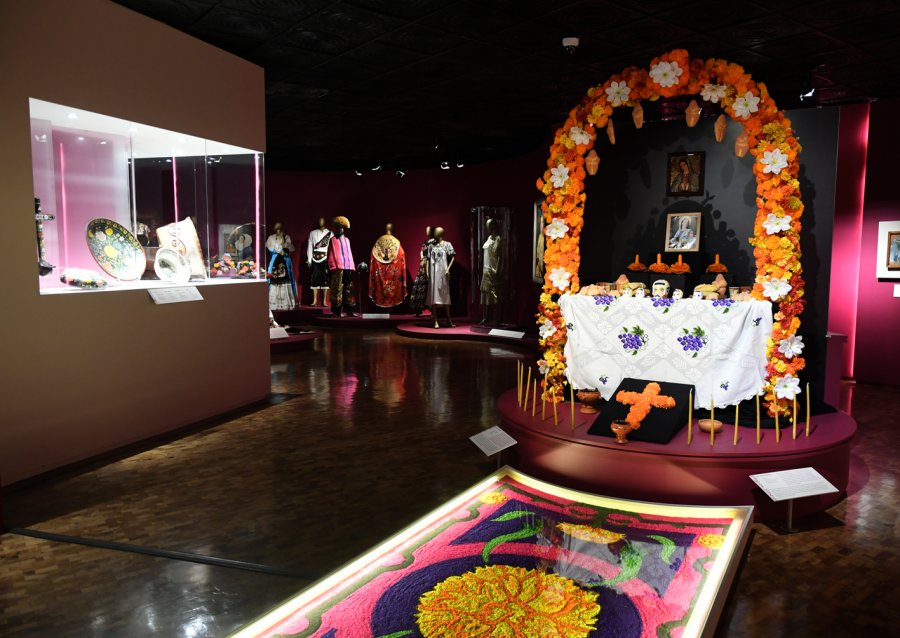Noticias
Until June 17
Presentation of the tour of the flower in Mexican art at the National Museum of Anthropology
March 24, 2018The exhibition The Flower in Mexican Culture, which has been presented at the National Museum of Anthropology since March 16, offers an extensive, deep historical and esthetic journey through the representation of flowers in the art of our country since pre-Hispanic times.
After having been on display in the states of Yucatan and Zacatecas, the exhibition arrived at the Temporary Exhibition Hall of the most important museum in Mexico, where it will be open to the public until June 17.
A carved stone representing Xochiquétzal, from Xochicalco, welcomes the visitors to this exhibition which, curated by Sofía Martínez del Campo, is made up of 365 pieces, including ceramics, engraving, painting, sculpture, clothing and Mexican popular art.
Through five thematic sections, The Flower in Mexican Culture analyzes the flower as an essential symbol of representation, through a wide variety of works belonging to various INAH museums, in addition to the National Museum of Art and private collections.
In the first section, entitled The Flower: Metaphor of the precious, visitors can admire pre-Hispanic pieces from different cultures such as the Huastec sculpture of Macuilxóchitl, figurines of Xochipilli found in Tenochtitlán, fragments of murals from Teotihuacán, the brazier of the God of Agriculture in the Templo Mayor and a relief with flowers from Chichen Itzá.
Also on display are the facsimile of the Codex of Tututepetango, ceremonial boxes, pots, pans, bowls and dishes beautifully decorated with floral motifs, as well as stamps, earrings and earmuffs from different origins: Zapotec, Purepecha, Olmec and Mazatec.
In the second section of this exhibition, The Flower: Description of the Unknown, the plant richness of our country is presented, made up of nearly 30,000 species from different ecosystems: aquatic plants, mountain plants, meadows, lowland rainforest and tropical forest, through lithographs and other botanical records.
Samples of the UNAM herbarium of plants such as amaranth, maguey pulquero, white tuna, corn, aztec lily and toloache are presented along with the facsimile of the Deondrología natural by Fray Juan Caballero from the 18th century and photographs by Tina Modotti as well as studies by José María Velasco.
Then, in the section called The Flower: Allegory of the divine, the public will be able to admire New Spanish artwork in which the flower played an important symbolic role, since, for example, jasmine was related to paradise, while the red carnation signified the sacrifice and love of Jesus Christ for mankind.
Oil paintings such as Los desposorios de la Virgen by Cristóbal de Villalpando, Juan Diego by Miguel Cabrera and Cristo en el jardín de las delicias by José de Ibarra, are on display next to the 18th century Calavatra Cross, finely embroidered religious garments, banners and even the Capitular of the Choir Book by Bernardo de Silva from 1772 and 1774.
The tour continues with the section The Flower: symbol of the beautiful with works in which floral motifs by artists such as Germán Gedovius, David Alfaro Siqueiros, Olga Costa, María Izquierdo and Diego Rivera predominate, as well as other pieces such as parades, shawls, shawls, olinalá boxes and a wide variety of jewellery.
Finally, the public will enjoy a large flower mat made of coloured sawdust that opens the section The flower: Synthesis of the diverse that also presents an altar of the dead with the classic cempasúchil flower, a tree of life from Metepec and typical costumes such as tepehuana, campechana, parachico and Huichol clothing, in addition to embroidery, huipiles and quechquémitl.
The Flower in Mexican Culture, which incorporates multimedia resources with four videos on the symbolism of flowers in art, closes with La vendimia nacional by Jorge González Camarena (1946).
The public will be able to enjoy this exhibition until June 17 in the Temporary Exhibition Hall of the National Museum of Anthropology, located in Paseo de la Reforma and Gandhi s/n, from Tuesday to Sunday, from 9 am to 7 pm. Free admission.
Mexico,Distrito Federal
